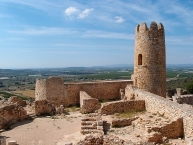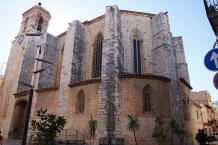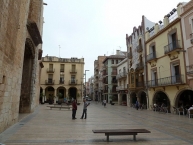Ulldecona
Sehenswürdigkeiten
Erstellt am 08.02.2021,
zuletzt geändert von biroto-Redaktion am 08.02.2021
Radwege und Fahrrad-Touren in der Nähe
| Name/Bezeichnung | Typ | km zur Strecke |
|---|---|---|
Route | 0,0 km | |
Tour | 0,1 km |
![]()
Bitte warten - Kartendaten werden geladen
Art der Sehenswürdigkeit
Historische(s) Gebäude
Name u. Anschrift
Ulldecona
ES-43550 Ulldecona
GEO-Daten
GEO-Koordinaten
40.59∎∎∎∎ 0.44∎∎∎∎
Höhe
139 m
Kommunikation
Informationen zu Urheber-Rechten | |
|---|---|
Rechte-Inhaber | |
Rechte-Ausprägung / Lizenz | by-sa: CREATIVE COMMONS Namensnennung, Weitergabe unter gleichen Bedingungen |
Link zur Rechtebeschreibung | |
Bild übernommen aus | https://commons.wikimedia.org/wiki/File:Burg_Ulldecona_(Spanien).jpg |
Bild hochgeladen | durch biroto-Redaktion am 08.02.2021
|
Informationen zu Urheber-Rechten | |
|---|---|
Rechte-Inhaber | https://commons.wikimedia.org/w/index.php?title=User:DagafeSQV |
Rechte-Ausprägung / Lizenz | by-sa: CREATIVE COMMONS Namensnennung, Weitergabe unter gleichen Bedingungen |
Link zur Rechtebeschreibung | |
Bild übernommen aus | https://commons.wikimedia.org/wiki/File:Església_parroquial_de_Sant_Lluc_01.JPG |
Bild hochgeladen | durch biroto-Redaktion am 08.02.2021
|
Informationen zu Urheber-Rechten | |
|---|---|
Rechte-Inhaber | |
Rechte-Ausprägung / Lizenz | by-sa: CREATIVE COMMONS Namensnennung, Weitergabe unter gleichen Bedingungen |
Link zur Rechtebeschreibung | |
Bild übernommen aus | https://commons.wikimedia.org/wiki/File:Centre_històric_(Ulldecona)P1050540.JPG |
Bild hochgeladen | durch biroto-Redaktion am 08.02.2021
|
Ulldecona is a municipality in the district of Montsiā that includes the cores El Castell, La Miliana, Sant Joan del Pas, Els Valentins and Les Ventalles. It is in the south of Catalonia forming the southern boundary of the Principality of Valencia. In 2013, it has about 6,200 inhabitants (2018). It has an important historical heritage that dates back to cave paintings (6000 BCE), Iberian remains, olive trees, Roman roads, medieval buildings, and neoclassical and modernist buildings.
Understand
Ulldecona is in the region of Montsiā, in southern Catalonia, in the middle of two large buttresses such as the Sierra del Montsiā east and west Serra de Godall.
History
After the Christian reconquest, Ulldecona castle was held by the family of Montcada, forming part of the term of Tortosa. The difficulties in the task of recruitment made in 1173, Guillem de Montcada ceded the castle to the Knights Hospitallers. The grant was confirmed in 1178 by King Alfons I d'Aragó and included parts of the current terms of Alcanar, Freginals and La Senia.
The castle was in the border area with the Saracens so suffered continuous attacks. Unable to defend, the hospital in 1191 the castle returned to the Montcada, but reserved the manor. The castle was expanded with the construction of a circular base tower, designed to protect the primitive installed in the core population known as Ulldecona Vella (Old Ulldecona).
In 1122, once the danger of Muslim attacks, the castle returned to the hospital as it was not necessary the presence of Montcada as defenders of the square. In 1227 there was established the hospital administration, led by Ramon de Cervera. This administration, management also known as Tortosa, held office until the 19th century
The early inhabitants were located near the area of protection of the castle, in a mountainous area that prevented its expansion. In 1274 they were granted permission to move to a mile, in the valley, and to establish there a new kernel under the name d'Ulldecona Sant Lluc (Saint Luke Ulldecona), origin of the current municipality.
In 1463 and 1465, the town was besieged by the troops of Joan II de Aragó since Ulldecona remained faithful to the Provincial Catalan. During the War of Spanish Succession was retained felipistas troops since 1708 so there were no clashes featured. The city was occupied by French troops from July 1810-1813 during the Spanish War of Independence.
See
⊙Medieval castle
Ulldecona Medieval Castle is on a small hill called Puig del Castell which is part of the Serra Grossa. This set is on the left bank Senia, the current political-administrative boundary between Catalonia and Valencia. The wide visibility and the great fertility of the land and wealth have assumed that this place has been over time a strategic area of control of the territory from the Iberian era to the Middle Ages.
Fortified ruins contain a small cylindrical tower, a main tower with a rectangular base that dominates the whole, the courtyard and the church of Santa Maria dels Angels. Two lines of wall have traces of Arabic origin and subsequent interventions, remains of two towers or bastions (of Arabic origin) where in one of them, it was surprisingly found in an excavation, a bronze figure representing Christ the King. This piece is unique in all the Ebro region and province of Tarragona and has been dated to the 13th century by comparison with others of that era.
There are interesting tours that let you enjoy a space key to understanding the history and territory over the last 2700 years.
⊙Church of Sant Lluc
The current Gothic church replaced the 13th-century church scaffolding to move people from the Castle to the valley. Its construction began in 1373 and 1421 was consecrated altar. It consists of a single nave divided into four sections and irregular side chapels between buttresses. The return is "creueria" with arches supported on pillars to the walls. It has windows "tracery" and two small rosettes. The access door is "arquivoltada" and is preceded by a porch. The decor is sparse, but the whole is wide and "solemnial". Subsequent building (second half of 18th century), there are the sacristy and the chapel of the shrine. In the sacristy, barrel back and with very interesting decorations and tiles "vidriades" Baroque conception predominates. The chapel's tabernacle, Greek cross plan and neoclassical spirit, will be restored in 1998 and is chaired by the image of the Pietat, patroness of the villa.
The 1936, during the Civil War, was destroyed Altarpiece of Sant Lluc, polychrome wood and fabrics which were part 16. The fabrics were saved from destruction, but due to the large size were separated from their racks and frames to be transferred to the Convent of the Nuns Agustines. These fabrics are attributed Sarinyena school, Valencian family "retaulistes" and painters active at the end of the 16th and early 17th centuries. Most of these fabrics have been restored and can be seen in the chapel of the sacristy. The most prominent are the Holy Trinity, 300 x 200 cm, The Coronation of Mary, 390 x 330, and the Burial of the Virgin Mary, 392 x 335 cm.
⊙Old Town
In addition to the Church and the arcaded square, the old town holds numerous stately homes among which the Casa de la comanda, former home of the "comanadors" of the 15th century, a time at which preserved vestiges belong to the façade. On the ground floor highlights the central portal "dovellat" stone, in the central sector there are two shields engraved with the emblems of the Order of the Hospital, in addition to a third above the door that has a phrase undeciphered. Main floor center window geminada interested, a copy of the Castle, as a symbol of power.
Also of note is the restored Casa Mossén Domingo Solà, founder of the Social Work Ekumene. Manor house of the century where you can see the equipment used to work the field, or the kitchen. Thanks to the contributions of ordinary people. In addition there are a number of popular-baroque mansions (17th and 18th centuries) on the streets of the Puríssima and Sant Cristófol with interesting doorways, entrances and "barbacanes".
In a unique charm are the narrow streets of Embut (Roger de Llúria) del Carme la Placeta dels Frares, which retain, among other interesting aspects, bridges between the two facades. There dispersions within and outside the core how historic homes "noucentistes" and modernist, mainly :Aribau, La Purísima, Sant Cristòfol Mártir, Sant Lluc y al Passeig de l'Estació.
A large proportion of the old houses are uninhabited. Some are only used as warehouse or garage.
⊙Convent of Sant Domènech
The municipality offices are now on its premises. Building the transition between the Baroque and neoclassical 18th century, a square arranged around a central cloister impressive five arches per band. In 1991 it was redesigned to suit administrative needs of the City but the setting was respected and cloister wall was missing a modern metal structure. The facade is a lock rectangular blocks. The door is a framing allindada classicista and above the door is a niche with the image of Sant Lluc Ulldecona pattern.
⊙Roser Church
Now the House of Culture. Just in front of the former Convent de Sant Domènech (Town Hall) are the Casa de la Cultura, modern building that has been restored respecting the old church rectangular Roser of five sections and square apse, side chapels between buttresses to the nave, the section of the ship that touches the apse want to simulate a cruise. On the old heart and extending toward the center of the church has been at the library. The cover is creueria and has topped the pseudocreuer with an interesting metal spherical dome. The door is "dovellada" from arch and belfry is little high and square section. The exterior is complete with pillars and lintels by way of false buttresses and a small garden.
⊙House of the Feligresa
In the square there is a gallery arcade church, popularly called Pèrxens, from different eras and materials, on which rise dwellings; highlights parishioner House, designed by Cesar Martinell (disciple of Gaudí), the structure and decoration typically modernist. Located on two arches of Tudor art modified profile. It's interesting work of graffiti wall wrought: it represents the Catalan flag framed within a diamond around which are organized unique motifs (bows, tinsel.).
⊙Church and Convent of the nuns Agustines
Dedicated to Santa Magdalena, rise edge Vinaròs the old portal (now Plaça Sales i Ferré, "La Mera"). Built on a primitive house where the nuns were installed provisionally dated 1724. The foundation must Romuald Simon de Pallares, old comanador Hospital Order. The early church was overthrown 1848, and reconsecrated in 1876. It is inhabited by a community of nuns. Due to the various wars the convent has been unemployed several times. The church is rectangular apses plant and consists of four sections and barrel vault resting on pilasters with composite capitals.
⊙L'Orfeó
The Municipal Theatre is an eclectic building with a facade that retains the original structure of 1923, when it was built. Highlights include the large balcony "balustrade" and "ledge-entaulament" classically inspired with central ceiling tile "glazed" it reads "Orfeo Montsiā" coral entity par excellence of our villa and founder of the Theatre.
Nützliche Information
Im Umkreis von 4 km:
- ⊙ Tourist-Information Ulldecona, Ulldecona
Informationen zu Urheber-Rechten | |
|---|---|
Rechte-Ausprägung / Lizenz | by-sa: CREATIVE COMMONS Namensnennung, Weitergabe unter gleichen Bedingungen |
Link zur Rechtebeschreibung | |
Text(e) übernommen von: |
Wikivoyage contributors, 'Ulldecona', Wikivoyage, The FREE worldwide travel guide that anyone can edit, 29 December 2020, 14:00 UTC, https://en.wikivoyage.org/w/index.php?title=Ulldecona&oldid=4122564 [accessed 8 February 2021] |
übernommen / bearbeitet am | 08.02.2021
|
übernommen / bearbeitet durch |
|
Radwege und Fahrrad-Touren in der Nähe
| Name/Bezeichnung | Typ | km zur Strecke |
|---|---|---|
Route | 0,0 km | |
Tour | 0,1 km |
Erstellt am 08.02.2021,
zuletzt geändert von biroto-Redaktion am 08.02.2021



